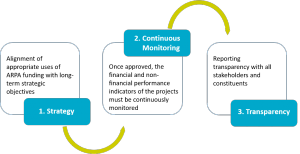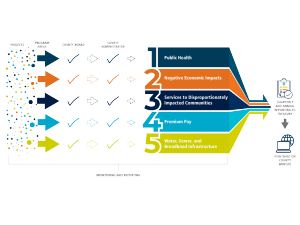Reporting requirements for the American Rescue Plan Act money—what cities and counties should consider
Funding provided through the American Rescue Plan Act (ARPA) provides communities with an unprecedented opportunity to impact the lives of their citizens through prudent spending in the following four categories:
- To respond to the COVID-19 public health emergency and/or its negative economic impact.
- To respond to essential workers during the COVID-19 public health emergency by providing premium pay to such eligible workers of the recipient, or by providing grants to eligible employers that have eligible workers who performed essential work.
- For the provision of government services, to the extent of the reduction in revenue of such recipient due to the COVID–19 public health emergency, relative to revenues collected in the most recent full fiscal year of the recipient prior to the emergency.
- To make necessary investments in water, sewer or broadband infrastructure.
Given the size of the funding that governments are receiving, many are struggling with where to begin the necessary documentation and reporting. The following provides government leaders with a framework for managing their ARPA processes:

Strategic Phase
In this phase, the government should identify the priority areas where its constituents want to see the ARPA funds expended and provide constituents with a mechanism to submit project ideas for funding consideration. We believe that it is critical to engage all stakeholders in the community to understand what the community prioritizes in use of these ARPA funds.

While gathering feedback from the community, governments should organize a steering committee to begin to administer their ARPA process. A member of senior management of the government should chair the committee, and the committee should have strong representation from key areas of government—health, public safety, public works, etc. Many governments are also including “outside” members on this committee to help ensure that community voices, many of which are reflected in the graphic above, are heard.
Once a committee with the right composition is established, the committee needs to develop a set of “guiding principles” that it will use to screen project requests from the government and from the community. These guiding principles ensure that there is consideration given to how the project will fit into the short and long-term goals of the government, how the project reflects the priorities identified from the community engagement, and how the project achieves the community equity goals established in the ARPA legislation. Project screening should be composed of three steps: (1) is the project an allowable use of ARPA funds; (2) does the project fit within the established guiding principles; and (3) is the project sponsor capable of handling the administrative requirements of this project.
Governments need to consider that there are many new requirements to gather and report non-financial data on these ARPA funded projects, a significant change from past grants management practices. Governments now need to ensure that the project sponsor is aware of these new requirements and has the administrative systems, both financial and non-financial, to be able to comply with these requirements. We strongly recommend that the government provide prospective project sponsors with an overview of the reporting requirements to which they will need to adhere so that they can consider those prior to submitting a project funding request.
Once the project is approved governments need to ensure that the vendor contract or the subrecipient agreement, whichever is applicable, reflects all the information that the vendor/subrecipient must submit. Again, ARPA requires significantly greater non-financial measures for each project. We recommend that the following elements, at a minimum, are included in all agreements for projects funded by ARPA:
- project name
- funding amount
- identification number (created by the government and used thereafter in the quarterly Program and Expenditure Report)
- federal project expenditure category
- a description of the project which includes:
- an overview of the main activities of the project
- the approximate timeline
- primary delivery mechanisms and partners, if applicable
- intended outcomes (include a link to the website of the project if available)
- required performance indicators and programmatic data
- required quarterly reporting data
- required annual reporting data
If governments do not specifically provide this information in the agreement, they risk not being able to obtain it to include in their required Treasury reporting.
Additionally, governments will need to design reports for management and elected officials. Ultimately, governments will need to provide the following project level data to the Treasury quarterly:
Expenditures: Once a project is approved, governments will be required to report on the project’s obligations and expenditures as follows:
- current period obligation
- cumulative obligation
- current period expenditure
- cumulative expenditure
Project Status: Once a project is started, governments will be asked to report on project status for each reporting period, in four categories:
- not started
- completed less than 50 percent
- completed 50 percent or more
- completed
Governments will further summarize the project level data into the following Treasury required categories:
- Public Health
- Negative Economic Impacts
- Services to Disproportionately Impacted Communities
- Premium Pay
- Water, Sewer and Broadband Infrastructure
- Revenue Loss
- Administrative
As described in the graphic below, this information should be provided to the city manager/county administrator, mayor, and elected officials at least monthly so that these parties can exercise their oversight responsibilities. All parties should agree upon the level of detail in these reports up front. Finally, governments will need to post their annual report to the Treasury on their website.

- Ultimately governments should consider several items as they begin their ARPA journey. First, engage the community to identify their priorities. Just as critical, ensure to develop guiding principles to align their projects with the government’s priorities. It’s also important to include all required information needs in contracts and to establish standard data elements for all projects to facilitate monitoring and reporting. Lastly, governments should obtain agreement on the reporting format to management and elected officials.
This up-front planning before spending ARPA funding will greatly facilitate all subsequent compliance activities and ultimately ensure that significant funds are reaching the local communities.
Jack Reagan, state and local government practice group leader with UHY Advisors Inc., has more than 30 years of experience serving state and local governments, local school districts, federal government entities and not-for-profit organizations as both an auditor and consultant, and has served many of the largest state and local government entities throughout the country. He is currently assisting several local governments in their ARPA process. He can be reached at (410) 423-4832 or [email protected].



















